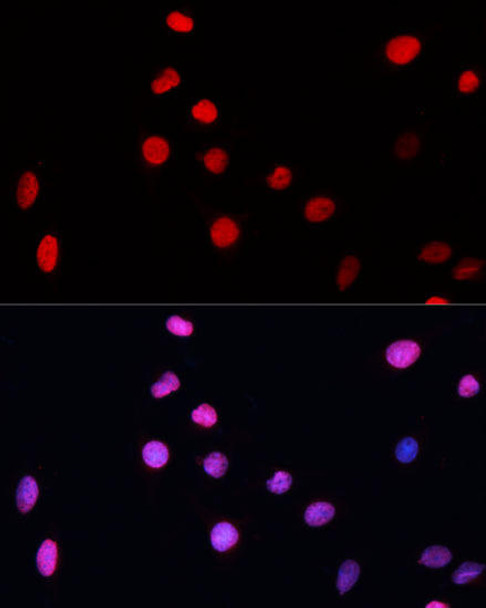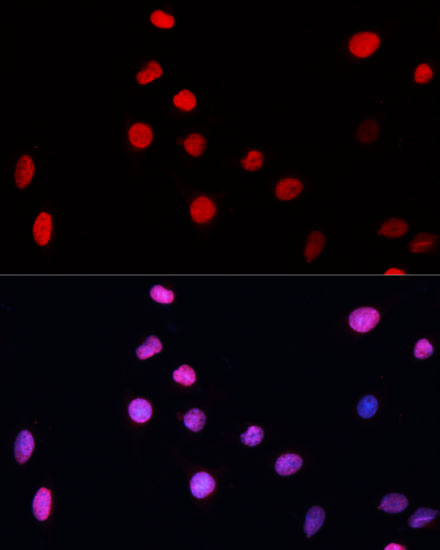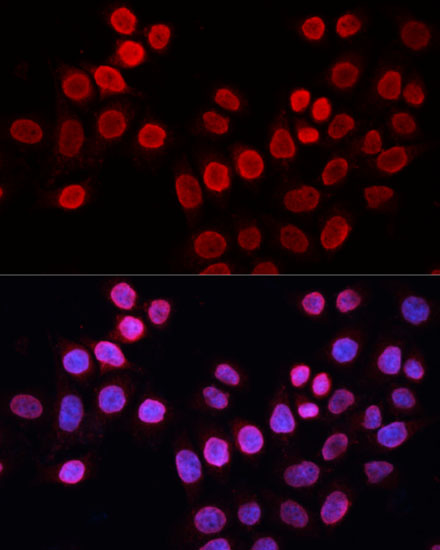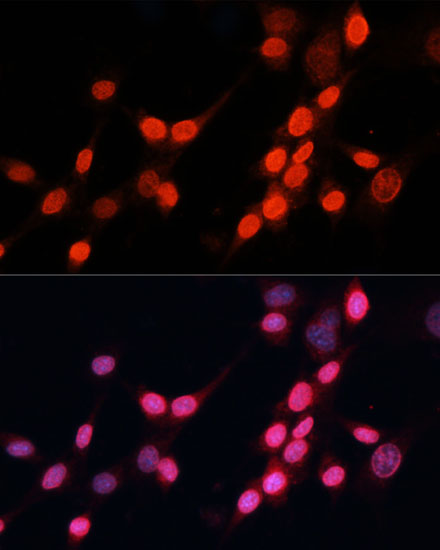Epigenetics & Nuclear Signaling Antibodies 2
Anti-ERCC5 Antibody (CAB1605)
- SKU:
- CAB1605
- Product Type:
- Antibody
- Reactivity:
- Human
- Reactivity:
- Mouse
- Reactivity:
- Rat
- Host Species:
- Rabbit
- Isotype:
- IgG
- Antibody Type:
- Polyclonal Antibody
- Research Area:
- Epigenetics and Nuclear Signaling
Description
| Antibody Name: | Anti-ERCC5 Antibody |
| Antibody SKU: | CAB1605 |
| Antibody Size: | 20uL, 50uL, 100uL |
| Application: | IF |
| Reactivity: | Human, Mouse, Rat |
| Host Species: | Rabbit |
| Immunogen: | Recombinant fusion protein containing a sequence corresponding to amino acids 1-270 of human ERCC5 (NP_000114.2). |
| Application: | IF |
| Recommended Dilution: | IF 1:50 - 1:200 |
| Reactivity: | Human, Mouse, Rat |
| Positive Samples: | fetal brain |
| Immunogen: | Recombinant fusion protein containing a sequence corresponding to amino acids 1-270 of human ERCC5 (NP_000114.2). |
| Purification Method: | Affinity purification |
| Storage Buffer: | Store at -20'C. Avoid freeze / thaw cycles. Buffer: PBS with 0.02% sodium azide, 50% glycerol, pH7.3. |
| Isotype: | IgG |
| Sequence: | MGVQ GLWK LLEC SGRQ VSPE ALEG KILA VDIS IWLN QALK GVRD RHGN SIEN PHLL TLFH RLCK LLFF RIRP IFVF DGDA PLLK KQTL VKRR QRKD LASS DSRK TTEK LLKT FLKR QAIK TAFR SKRD EALP SLTQ VRRE NDLY VLPP LQEE EKHS SEEE DEKE WQER MNQK QALQ EEFF HNPQ AIDI ESED FSSL PPEV KHEI LTDM KEFT KRRR TLFE AMPE ESDD FSQY QLKG LLKK NYLN QHIE HVQK EMNQ QHSG HIRR QYED EG |
| Gene ID: | 2073 |
| Uniprot: | P28715 |
| Cellular Location: | Nucleus |
| Calculated MW: | 27kDa/47kDa/133kDa |
| Observed MW: | 133kDa |
| Synonyms: | ERCC5, COFS3, ERCC5-201, ERCM2, UVDR, XPG, XPGC |
| Background: | This gene encodes a single-strand specific DNA endonuclease that makes the 3' incision in DNA excision repair following UV-induced damage. The protein may also function in other cellular processes, including RNA polymerase II transcription, and transcription-coupled DNA repair. Mutations in this gene cause xeroderma pigmentosum complementation group G (XP-G), which is also referred to as xeroderma pigmentosum VII (XP7), a skin disorder characterized by hypersensitivity to UV light and increased susceptibility for skin cancer development following UV exposure. Some patients also develop Cockayne syndrome, which is characterized by severe growth defects, mental retardation, and cachexia. Read-through transcription exists between this gene and the neighboring upstream BIVM (basic, immunoglobulin-like variable motif containing) gene. |
| UniProt Protein Function: | XPG: Single-stranded structure-specific DNA endonuclease involved in DNA excision repair. Makes the 3'incision in DNA nucleotide excision repair (NER). Acts as a cofactor for a DNA glycosylase that removes oxidized pyrimidines from DNA. May also be involved in transcription-coupled repair of this kind of damage, in transcription by RNA polymerase II, and perhaps in other processes too. Defects in ERCC5 are the cause of xeroderma pigmentosum complementation group G (XP-G); also known as xeroderma pigmentosum VII (XP7). Xeroderma pigmentosum is an autosomal recessive pigmentary skin disorder characterized by solar hypersensitivity of the skin, high predisposition for developing cancers on areas exposed to sunlight and, in some cases, neurological abnormalities. Some XP-G patients present features of Cockayne syndrome, including dwarfism, sensorineural deafness, microcephaly, mental retardation, pigmentary retinopathy, ataxia, decreased nerve conduction velocities. Belongs to the XPG/RAD2 endonuclease family. XPG subfamily. 2 isoforms of the human protein are produced by alternative splicing. |
| UniProt Protein Details: | Protein type:Deoxyribonuclease; EC 3.1.-.-; DNA repair, damage Chromosomal Location of Human Ortholog: 13q33 Cellular Component: DNA replication factor A complex; DNA-directed RNA polymerase II, holoenzyme; holo TFIIH complex; nucleoplasm; nucleus Molecular Function:bubble DNA binding; double-stranded DNA binding; endodeoxyribonuclease activity; protein binding; protein homodimerization activity; protein N-terminus binding; single-stranded DNA binding Biological Process: negative regulation of apoptosis; nucleotide-excision repair, DNA incision; nucleotide-excision repair, DNA incision, 3'-to lesion; nucleotide-excision repair, DNA incision, 5'-to lesion; nucleotide-excision repair, preincision complex assembly; nucleotide-excision repair, preincision complex stabilization; response to UV; response to UV-C; transcription-coupled nucleotide-excision repair; UV protection Disease: Xeroderma Pigmentosum, Complementation Group G |
| NCBI Summary: | This gene encodes a single-strand specific DNA endonuclease that makes the 3' incision in DNA excision repair following UV-induced damage. The protein may also function in other cellular processes, including RNA polymerase II transcription, and transcription-coupled DNA repair. Mutations in this gene cause xeroderma pigmentosum complementation group G (XP-G), which is also referred to as xeroderma pigmentosum VII (XP7), a skin disorder characterized by hypersensitivity to UV light and increased susceptibility for skin cancer development following UV exposure. Some patients also develop Cockayne syndrome, which is characterized by severe growth defects, mental retardation, and cachexia. Read-through transcription exists between this gene and the neighboring upstream BIVM (basic, immunoglobulin-like variable motif containing) gene. [provided by RefSeq, Feb 2011] |
| UniProt Code: | P28715 |
| NCBI GenInfo Identifier: | 205371791 |
| NCBI Gene ID: | 2073 |
| NCBI Accession: | P28715.3 |
| UniProt Secondary Accession: | P28715,Q5JUS4, Q5JUS5, Q7Z2V3, Q8IZL6, Q8N1B7, Q9HD59 Q9HD60, A6NGT4, |
| UniProt Related Accession: | P28715 |
| Molecular Weight: | 27,259 Da |
| NCBI Full Name: | DNA repair protein complementing XP-G cells |
| NCBI Synonym Full Names: | ERCC excision repair 5, endonuclease |
| NCBI Official Symbol: | ERCC5 |
| NCBI Official Synonym Symbols: | XPG; UVDR; XPGC; COFS3; ERCM2; ERCC5-201 |
| NCBI Protein Information: | DNA repair protein complementing XP-G cells |
| UniProt Protein Name: | DNA repair protein complementing XP-G cells |
| UniProt Synonym Protein Names: | DNA excision repair protein ERCC-5; Xeroderma pigmentosum group G-complementing protein |
| Protein Family: | DNA repair protein |
| UniProt Gene Name: | ERCC5 |
| UniProt Entry Name: | ERCC5_HUMAN |









